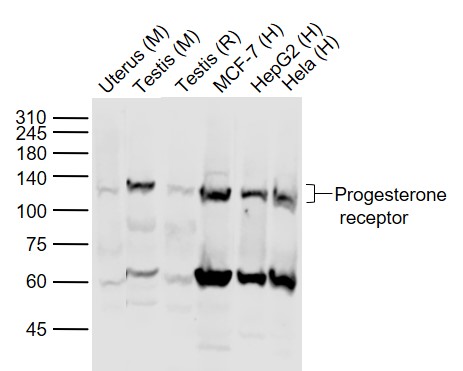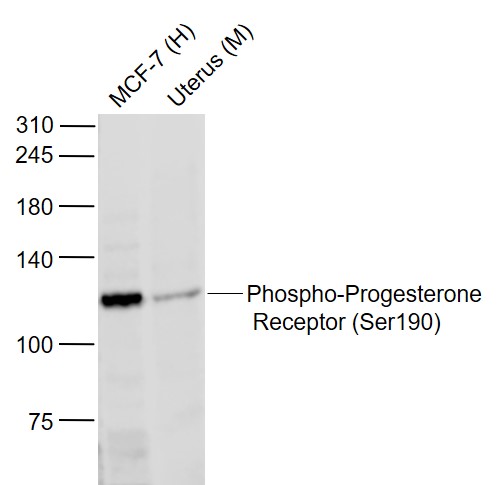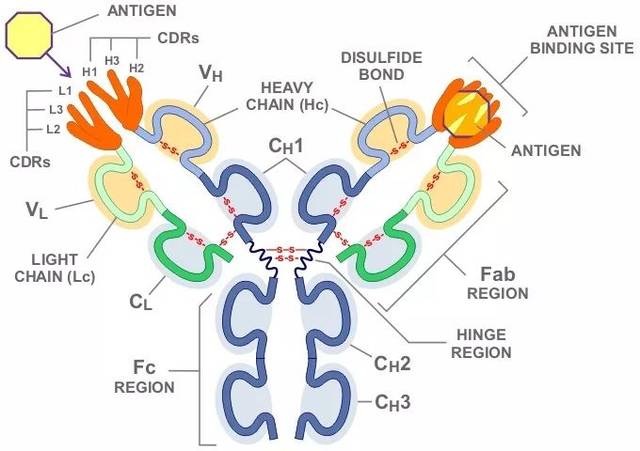Product Name :
Phospho-Progesterone Receptor(Ser190) Polyclonal Antibody Background :
Estrogen and progesterone receptor are members of a family of transcription factors that are regulated by the binding of their cognate ligands. The interaction of hormone-bound estrogen receptors with estrogen responsive elements(EREs) alters transcription of ERE-containing genes. The carboxy terminal region of the estrgen receptor contains the ligand binding domain, the amino terminus serves as the transactivation domain, and the DNA binding domain is centrally located. Two forms of estrogen receptor have been identified, ER alpha and ER beta. ER alpha and ER beta have been shown to be differentially activated by various ligands. The biological response to progesterone is mediated by two distinct forms of the human progesterone receptor (hPR-Aand hPR-B), which arise from alternative splicing. In most cells, hPR-B functions as a transcriptional activator of progesterone-responsive gene, whereas hPR-A function as a transcriptional inhibitor of all steroid hormone receptors. Product :
0.01M TBS(pH7.4) with 1% BSA, 0.03% Proclin300 and 50% Glycerol. Storage&Stability :
Store at 4°C short term. Aliquot and store at -20°C long term. Avoid freeze-thaw cycles. Specificity :
Phospho-Progesterone Receptor (Ser190) Polyclonal Antibody detects endogenous levels of Phospho-Progesterone Receptor protein only when phosphorylated at Ser190 Immunogen :
KLH conjugated Synthesised phosphopeptide derived from rat Progesterone Receptor around the phosphorylation site of Ser190 Conjugate :
Unconjugated Modification :
Phosphorylation
Phospho-Progesterone Receptor(Ser190) Polyclonal Antibody Background :
Estrogen and progesterone receptor are members of a family of transcription factors that are regulated by the binding of their cognate ligands. The interaction of hormone-bound estrogen receptors with estrogen responsive elements(EREs) alters transcription of ERE-containing genes. The carboxy terminal region of the estrgen receptor contains the ligand binding domain, the amino terminus serves as the transactivation domain, and the DNA binding domain is centrally located. Two forms of estrogen receptor have been identified, ER alpha and ER beta. ER alpha and ER beta have been shown to be differentially activated by various ligands. The biological response to progesterone is mediated by two distinct forms of the human progesterone receptor (hPR-Aand hPR-B), which arise from alternative splicing. In most cells, hPR-B functions as a transcriptional activator of progesterone-responsive gene, whereas hPR-A function as a transcriptional inhibitor of all steroid hormone receptors. Product :
0.01M TBS(pH7.4) with 1% BSA, 0.03% Proclin300 and 50% Glycerol. Storage&Stability :
Store at 4°C short term. Aliquot and store at -20°C long term. Avoid freeze-thaw cycles. Specificity :
Phospho-Progesterone Receptor (Ser190) Polyclonal Antibody detects endogenous levels of Phospho-Progesterone Receptor protein only when phosphorylated at Ser190 Immunogen :
KLH conjugated Synthesised phosphopeptide derived from rat Progesterone Receptor around the phosphorylation site of Ser190 Conjugate :
Unconjugated Modification :
Phosphorylation
-
 Sample: Lane 1: Uterus (Mouse) Lysate at 40 ug Lane 2: Testis (Mouse) Lysate at 40 ug Lane 3: Testis (Rat) Lysate at 40 ug Lane 4: MCF-7 (Human) Cell Lysate at 30 ug Lane 5: HepG2 (Human) Cell Lysate at 30 ug Lane 6: Hela (Human) Cell Lysate at 30 ug Primary: Anti-progesterone receptor at 1/1000 dilution
Sample: Lane 1: Uterus (Mouse) Lysate at 40 ug Lane 2: Testis (Mouse) Lysate at 40 ug Lane 3: Testis (Rat) Lysate at 40 ug Lane 4: MCF-7 (Human) Cell Lysate at 30 ug Lane 5: HepG2 (Human) Cell Lysate at 30 ug Lane 6: Hela (Human) Cell Lysate at 30 ug Primary: Anti-progesterone receptor at 1/1000 dilution -
 Sample: Lane 1: MCF-7 (Human) Cell Lysate at 30 ug Lane 2: Uterus (Mouse) Lysate at 40 ug Primary: Anti-Phospho-Progesterone Receptor (Ser190) at 1/1000 dilution
Sample: Lane 1: MCF-7 (Human) Cell Lysate at 30 ug Lane 2: Uterus (Mouse) Lysate at 40 ug Primary: Anti-Phospho-Progesterone Receptor (Ser190) at 1/1000 dilution
Bioworld Biotech only provide peptides for our antibodies and do not provide additional peptide customization services.
Price/Size :
USD 368/1mg/vial
Tips:
For phospho antibody, we provide phospho peptide(0.5mg) and non-phospho peptide(0.5mg).Describe :
Blocking peptides are peptides that bind specifically to the target antibody and block antibody binding. These peptide usually contains the epitope recognized by the antibody. Antibodies bound to the blocking peptide no longer bind to the epitope on the target protein. This mechanism is useful when non-specific binding is an issue, for example, in Western blotting (WB) and Immunohistochemistry (IHC). By comparing the staining from the blocked antibody versus the antibody alone, one can see which staining is specific; Specific binding will be absent from the western blot or IHC performed with the neutralized antibody.Formula:
Synthetic peptide was lyophilized with 100% acetonitrile and is supplied as a powder. Reconstitute with 0.1 ml DI water for a final concentration of 10 mg/ml.The purity is >90%,tested by HPLC and MS.
Storage:
The freeze-dried powder is more stable. For short time at 2-8°C. For long term storage store at -20°C.
Note :
This product is for research use only (RUO only). Not for use in diagnostic or therapeutic procedures.
 Phospho-Progesterone Receptor(Ser190) Polyclonal Antibody
Phospho-Progesterone Receptor(Ser190) Polyclonal Antibody  Datasheet
Datasheet COA
COA MSDS
MSDS SHIP
SHIP